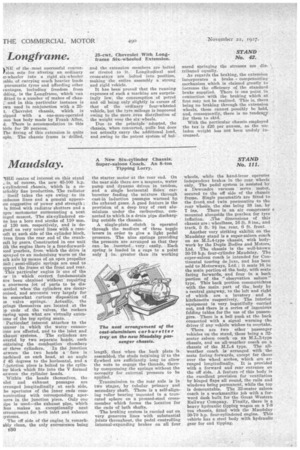Maudslay.
Page 154

If you've noticed an error in this article please click here to report it so we can fix it.
11g.E centre of interest on this stand _ is, of course, the new 45-100 h.p.
s-cylindered schassis, which is a re
[trkably fine production. The radiator itself takes the eye owing to its indsomme lines and a general appear ice suggestive of power and strength; is fitted with radiator shutters and a oyce motometer surmounting a neat inged mascot. The six-cylindered en
ne has a bore and stroke of 110 rum.
id 130 mm. respectively, and is de gned on very novel lines with a cam taft at each side of the cylinder block, iven from the rear end of the cranktaft by gears. Constructed in one unit ith the engine there is a four-forwardteed gearbox, from which the drive is niveyed to an mulerslung worm on the ack axle by means of an open propeller salt; semi-elliptic springs are used to apport the frame at the front and rear.
This particular engine is one of the mw in which' correct fundamentals ave been obtained without requiting a enormous lot of parts to be dismantled when the cylinders are decaronized, and accounts very largely for he somewhat curious disposition of re valve springs. Actually, the prings themselves are located at the op ends of the valves, the rockers easing upon what are virtually extenions of the top spring seats.
Particular! Interest attaches to the tanner in which the water cannerions are effected, and to the inlet and xhaust systems. The cylinders are overed by two separate heads, each ontaining the combustion chambers
or three cylinders. In the junction etweeu the two heads a face is reclined on each head, at an angle f 45 degrees to the horizontal, and a /Junction piece is bolted to the eylinler block which fits into the V formed metween the cylinder heads.
Within the heads themselves, the ulet and exhaust passages are trranged longitudinally at each side, he apertures of the inner ends comnunicating with corresponding apes.nres in the junction piece. Only one Ape is used—the exhaust pipe, which :bus makes an exceptionally neat irraugement for both inlet and exhaust
;Weals.
The off side of the engine is remarkably clean, the only excrescence being ISO the starter motor at the rear end. On the near side there are a magneto, water pump and dynamo driven in tandem, and a single horizontal Solex carburetter feeding the mixture through cast-in induction passages warmed by. the exhaust gases. A good feature is the provision of a deep tray of cast aluminium under the carburetter, connected to which is a drain pipe discharging outside the chassis.
A single-plate clutch is operated through the medium of three toggle levers in order to give a light pedal pressure. The nine springs providing the pressure are arranged so that they can be inserted very easily. Each spring is loaded in e cage to a point
only in. greater than its working length, thus when the back plate is assembled, the studs retaining it to the flywheel are sufficiently long to allow the nuts to engage the threads, thereby compressing the springs without the necessity for external pressure to be applied.
Transmission to the rear axle is in two stages, by tubular primary and secondary shaft. There is a self-aligning roller bearing mounted in a truncated sphere on a pressed-steel crossmember which forms the location for the ends of both shafts.
The braking system is ,carried out on very generous lines with substantial joints throughout, the pedal controlling internal-expauding brakes on all four wheels, while the hand-lever operates independent brakes in the rear wheels only. The pedal system is assisted by a Dewandre vacuum servo motor, secured to the off side of the chassis frame. Single pneumatids are fitted to the front and twin pneumatics to the rear wheels, the size being 38 ins. by 7 ins. There is an air compressor mounted alongside the gearbox for tyre inflation. ..The dimensions of this chassis are : wheelbase, 16 ft. 8 ins., and track, 5 ft. 9 ins. rear, 6 ft. front.
Another very striking exhibit on the Maudslay stand is a super-saloon coach on an hI.L.4-type chassis, with bodywork by the Duple Bodies and Motors, Ltd. The chassis is the well-known 30-70 hp. four-cylinder Maudslay. The super-saloon coach is intended for Continental touring de luxe, and has been sold to Motorways, Ltd.; it seats 16 in the main portion of the body, with seats facing forwards, and four in a back portion of the "observation saloon" type. This back portion communicates with the main part of the . body by a central gangway, to the left and right of which are a lavatory and a kitchenette respectively. The interior equipment is very beautifully carried out, ano) there is a series of ingenious folding tables for the use of the passengers. There is a bell push at the back connected with a signal warning the driver if any vehicle wishes to overtake.
There are two other • passenger vehicles on the stand, these being a 32seater saloon coach on an M.L.3-type chassis, and an all-weather coach on a chassis of the bL1a4 type. The allweather coach is arranged with the seats facing forwards, except for thesal over the wheel arches, which are arranged longitudinally. It is provided with a forward and rear entrance on the off side. A feature nf this body is the excellent provision for ventilation by hinged flaps all round, the rails and windows being permanent, while the top is demountable. The 32-seater saloon coach is a workmanlike job with a forward dash built for the Great Western Railway Company. Finally, there is a heavy hydraulic tipping wagon on a 7-8 ton chassis, fitted with the Maudslay 30-70 hp. four-cylindered engine. This . vehicle has a steel body with hydraulic gear for end tipping.


















































































































































































































































































































